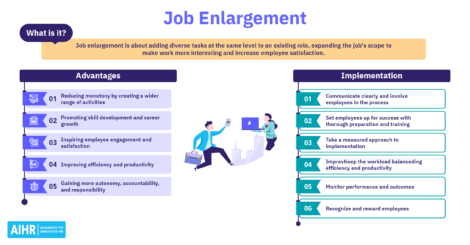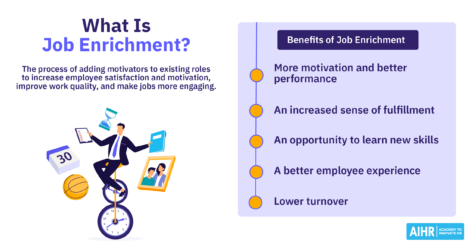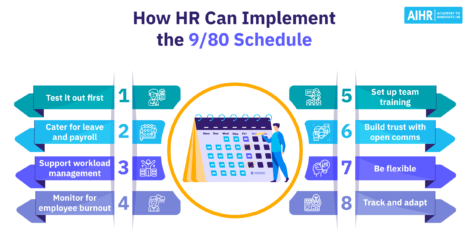Job simplification: 5 best practices

Job simplification, also referred to as work simplification, is a job design intervention. In this article, we will take a closer look at work simplification, give a definition, and list a number of best practices on how to do it well.
Contents
What is work simplification? A definition
Job simplification: a brief history
5 work simplification techniques
What is work simplification? A definition
Work or job simplification is the process of removing tasks from existing roles in order to make them more focused. The objective of work simplification is to develop improved work methods that maximize output while minimizing expenditure and cost.
Let’s look at an example of job simplification at work.
Amy works at the reception of a fast-growing company. Her role is to handle administration, take care of office chores, and receive guests. Amy loved her work. However, when the company grew from 50 to 150 people over a two-year period, she started to drop the ball on her administrative tasks and started showing burnout symptoms. Over this two year period, Amy’s responsibilities stayed the same but the group of people she had to take care of, increased by 300%!
Her manager then sat her down and asked which parts of the role she loved the most. Amy loved the chores and receiving guests but the administrative tasks became too much for her. The company then decided to create an additional office manager function who would be dedicated to these administrative tasks. Amy’s responsibilities were reduced to the other two activities.
Job simplification: a brief history
Work simplification was popularized by Frederick Taylor. He advocated that complex jobs should be broken down into simple components. These are small tasks that are relatively easy to learn and execute. The advantage is that there is a low skill level required, it is cheaper for the organization, and there is less error due to specialization.
In Taylor’s approach, workers become specialists in their specific area. This approach was implemented first by Henry Ford, who was able to mass-produce cars at a much cheaper rate than any of his competition.
Another benefit for the employer is that employees are easier to replace as they are highly specialized and their skills are easy to learn. Employees are thus replaceable cogs in the production machine. This approach was referred to as the engineering approach, as the output (productivity) was the main criterium for making these design choices.
Due to an increase in automation and increased awareness of working conditions for employees, job simplification fell from popularity. Instead of an engineering approach, a motivational approach was championed. This approach focused on making jobs motivating to work on – especially for knowledge workers.
Regardless of the decrease in popularity,
job simplification remains one of the four key ways to design jobs. In
addition, an argument could be made to reintroduce job simplification as a
technique to simplify roles in an age were complex jobs can lead to stress and
health problems.
Job simplification is one of the four job design techniques that are a key part of organizational development, together with job enlargement, job enrichment, and job rotation.
A 5-step work simplification technique
The approach to work simplification has five steps and is not dissimilar to any job redesign process. The job or role is first analyzed and then optimized based on a number of criteria. The steps for job simplification are as follows.
- Selection of the job or activity to be studied. A good starting point is an activity that is time consuming or inefficient. Preferably, this is an activity that you are familiar with, otherwise, you should interview people who are familiar with the task to get a better understanding of the person doing it. This helps in understanding the activity.
- Collection of data and information regarding the selected job. Here the priority is to get all the facts and lists each individual step involved in doing the job.
- Questioning of everything the performance of the job. In this phase, you go through all the steps and facts and analyze everything by asking “why, where, when, who, and how”. Next, you investigate alternative procedures and circumstances.
- Development of possible improvements. Here you can use four criteria for all the different tasks. These are Eliminate, Combine, Rearrange, and Simplify. The goal here is to make work easier, safer, or more effective. In this phase, you should keep in mind that you can make use of tools, including physical instruments, digital technology, and automation. After this, write the results down and create a proposed new method.
- Evaluation of results and implantation of the improved method. Here you can test your new prototype, optimize and adjust based on initial results, and implement the improved method. This may include some stakeholder management or convincing a superior.
Although the above-mentioned approach was published as early as the 1950s, it is highly similar to today’s design thinking process. You try to understand the job and circumstances (emphasize), define the problem, analyze the process, prototype solutions, and test results.
That’s it for this brief guide on job simplification. To wrap up: the goal of job simplification is to develop work methods that maximize output while minimizing cost. It is, therefore, a very task-focused approach. However, there are also other factors to take into account, which include how motivating the job will be and if the new, simplified job fits with the employee on that job. If Amy had loved administrative tasks, she would not have been happy giving them up, showing the importance of also taking a human approach to work simplification.
Weekly update
Stay up-to-date with the latest news, trends, and resources in HR
Learn more
Related articles
Are you ready for the future of HR?
Learn modern and relevant HR skills, online













